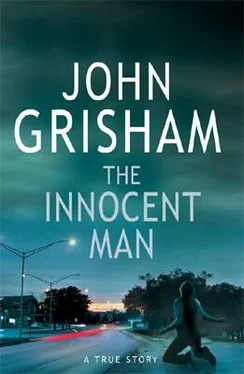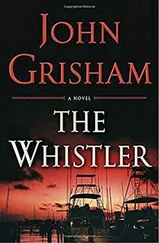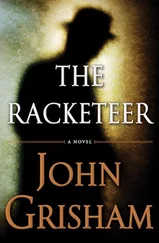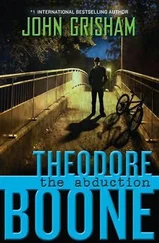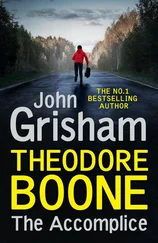He was moved back, but the damage was painfully clear.
Dennis Fritz heard the good news that Ron had prevailed at the federal level and would get another trial. Dennis had not been so lucky. Since he was not under a death sentence, he had no lawyer and was forced to file his own habeas corpus petition. He had lost at the district court level in 1995 and was appealing to the federal Tenth Circuit.
Ron's retrial was bittersweet for Dennis. He was dejected because he was convicted by the same witnesses and the same set of facts, yet his habeas appeal had been turned down. At the same time, he was very pleased that Ronnie would get another day in court.
In March 1996, he finally wrote the Innocence Project and requested their help. A student volunteer wrote back and sent a questionnaire. In June, the student requested Dennis's lab work-the analysis of his hair, blood, and saliva. Dennis had it neatly filed away in his cell, and he quickly sent it to New York. In August, he sent his appellate briefs, and in November he sent his entire trial transcript. Later that month, he received the wonderful news that the Innocence Project had officially taken his case.
Letters went back and forth, weeks and months passed. The Tenth Circuit denied his appeal, and when the Supreme Court refused to hear his case in May 1997, Dennis went through his own bout of depression. His appeals were over. All those wise judges sitting in their black robes and plowing through their thick law books had seen nothing wrong with his trial. Not a single one detected the obvious-an innocent man was wrongly convicted.
The future of life in prison that he had so strongly refused to believe was now a possibility. In May, he sent four letters to the Innocence Project. In 1979, in the small town of Okarche, just north of Oklahoma City, two men, Steven Hatch and Glen Ake, broke into the home of the Reverend Richard Douglass. In the ensuing ordeal, Douglass and his wife were shot and killed. Their two young children were also shot and left for dead; somehow they survived. The killing was done by Glen Ake, who was convicted and sentenced to death, then given a new trial because the judge had denied him access to a mental health expert. His appeal, Ake v. Oklahoma, was a landmark decision. At his second trial, he received a life sentence, which he is still serving.
Steven Hatch's participation in the killings was greatly in doubt and hotly disputed, but he nonetheless received the death penalty. On August 9, 1996, Hatch was strapped to the gurney and rolled into the death chamber on H Unit. Present in the witness room were the two Douglass children, adults by then.
Glen Ake, the unquestioned gunman, got life. Steven Hatch, who killed no one, was executed.
In 1994, a twenty-year-old American Indian named Scott Dawn Carpenter robbed a store in Lake Eufaula and murdered the owner. After only two years on death row, he was able to stop his appeals and get the needle.
On April 10, 1997, the Tenth Circuit Court of Appeals in Denver affirmed Judge Seay. The court took exception to his ban on hair evidence, but agreed that Ron Williamson had been wrongly convicted.
With a new trial in order, Ron's case was moved to the Capital Trial Division of the Indigent Defense System, where the new director, Mark Barrett, supervised a team of eight lawyers. Because of the complexity of the case, and because of his experience with Ron, he assigned the case to himself. The initial truckload of materials he received filled sixteen boxes.
In May 1997, Mark and Janet Chesley drove to McAlester to see the client. Janet's role was to reintroduce Mark to Ron. They had last seen each other in 1988, shortly after Ron arrived in F Cellhouse and Mark was assigned his first appeal.
Though he knew Janet and Kim Marks and most of the indigent appellate lawyers, and though he'd heard many rumors and tales of Ron and his adventures on death row, Mark was still startled at his condition. In 1988, Ron was thirty-five years old, weighed 220 pounds, and had an athletic build, confident walk, dark hair, and a baby face. Nine years later, he was forty-three and could easily have passed for sixty-five. After a year in the SCU, he was still gaunt, pale, disheveled, ghostlike, and obviously very sick.
But he was able to remain engaged through a long conversation about his case. He rambled at times, and drifted off into monologues that made no sense whatsoever, but for the most part he knew what was going on and where his case was headed. Mark explained that DNA testing would compare Ron's blood, hair, and saliva samples with the hair and semen found at the crime scene, and that the conclusion would be certain, guaranteed, foolproof. DNA doesn't lie.
Ron showed no hesitation; in fact he was eager to have the testing done. "I am innocent," he said over and over. "And I have nothing to hide."
Mark Barrett and Bill Peterson agreed that Ron should be evaluated to determine his mental competency. They also agreed on DNA testing. Peterson pushed hard for DNA because he was convinced it would finally nail Ron. The testing would have to wait, however, because Mark Barrett's austere budget wouldn't allow it. The cost was initially expected to be about $5,000, money that would not be available for a few months. It would eventually cost much more than the first estimate.
Instead, Mark went to work on the competency hearing. He and his rather lean staff compiled Ron's medical records. They located a psychologist who reviewed the records, interviewed Ron, and was willing to travel to Ada to testify. After two trips to the Oklahoma Court of Criminal Appeals, a one-year layover in Judge Seay's office, a two-year stop at the Tenth Circuit in Denver, two useless but required visits to the U.S. Supreme Court in Washington, and a truckload of routine filings back and forth among all these various courts, the matter of the state of Oklahoma versus Ronald Keith Williamson had now returned home.
It was back in Ada, ten years after four cops surrounded him, shirtless and shaggy and tinkering with a lawn mower with only three wheels, and arrested him for murder.
Tom Landrith was a third-generation native of Pontotoc County. He attended Ada High School and played on two state championship football teams. College and law school were at the University of Oklahoma, and when he passed the bar, he settled into his hometown and joined a small firm. In 1994, he ran for district court judge and easily defeated G. C. Mayhue, who had defeated Ronald Jones in 1990.
Judge Landrith was well acquainted with Ron Williamson and the Carter murder, and when the Tenth Circuit affirmed Judge Seay, he knew the case was headed back to Ada, to his courtroom. Typical of a small town, he had represented Ron on a drunk-driving charge in the early 1980s; they briefly played on the same softball team; Landrith played high school football with Johnny Carter, Debbie's uncle; and Landrith and Bill Peterson were old friends. During Ron's murder trial in 1988, Landrith had slipped into the courtroom several times out of curiosity. Of course, he knew Barney well.
It was Ada, and everybody knew everybody.
Landrith was a popular judge, folksy and funny, but strict in his courtroom. Though he had never been fully convinced Ron was guilty, he was not convinced he was innocent, either. Like most folks in Ada, he had always felt the guy had a loose screw or two. But he was anxious to see Ron, and to make sure his retrial was conducted fairly.
The murder was fifteen years old and still unsolved. Judge Landrith had great sympathy for the Carters and their ordeal. It was time to settle the matter.
On Sunday, July 13, 1997, Ron Williamson left McAlester, never to return. He was driven by two Pontotoc County deputies to Eastern State Hospital in Vinita. The sheriff, Jeff Glase, told a newspaper reporter that the prisoner behaved himself.
Читать дальше
